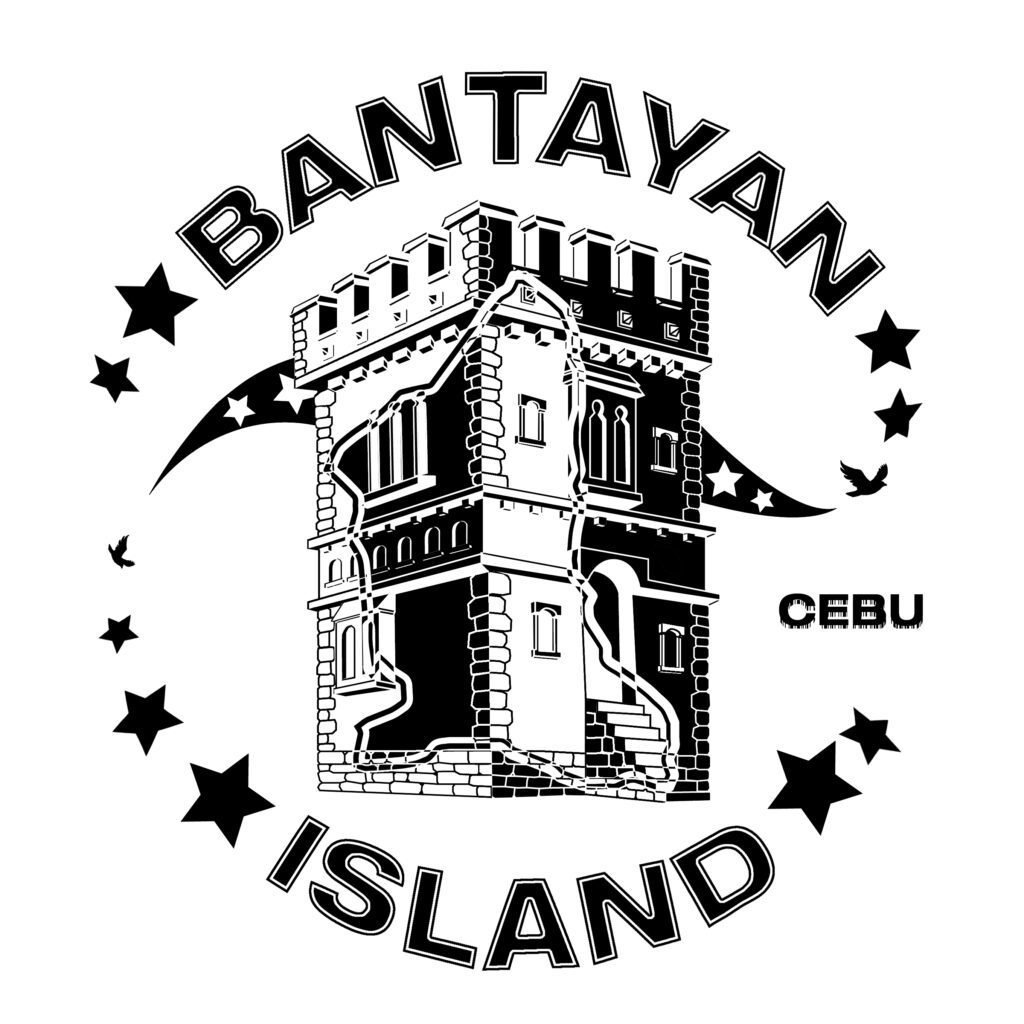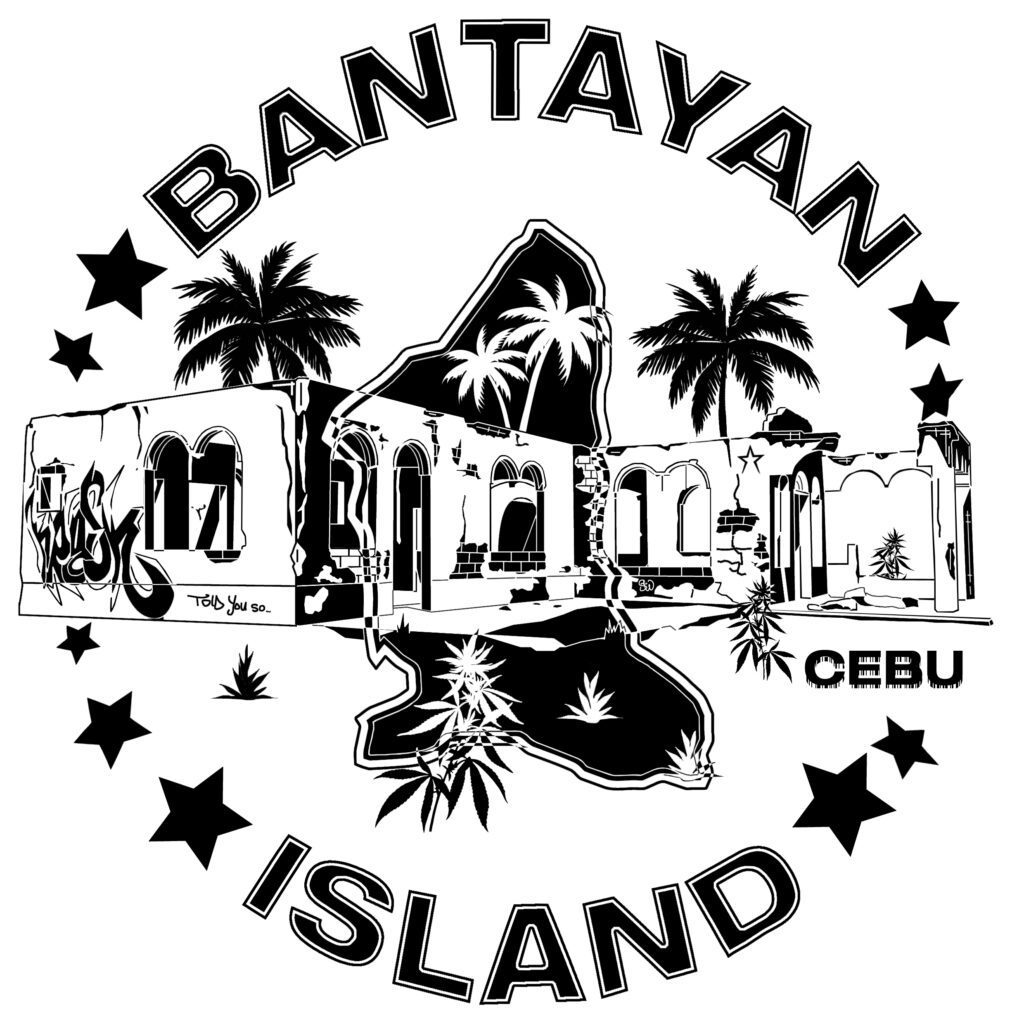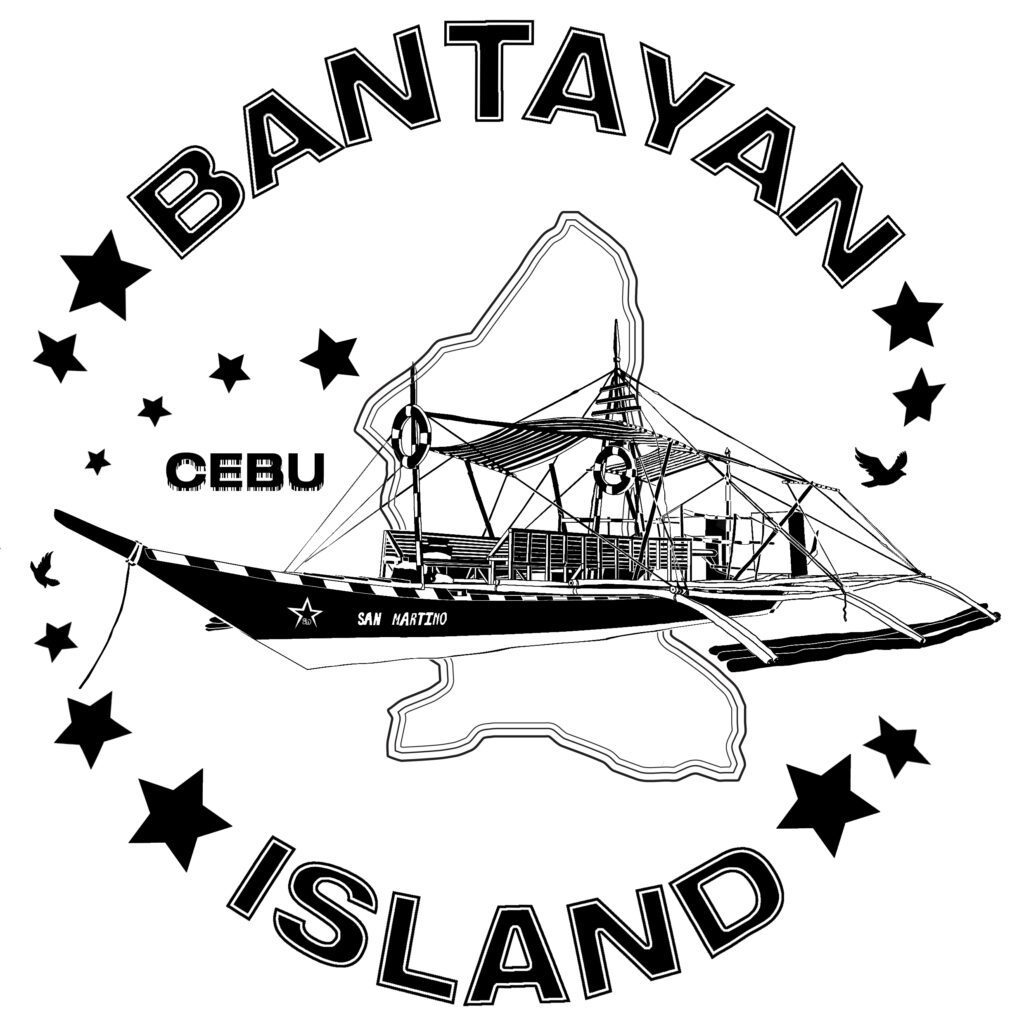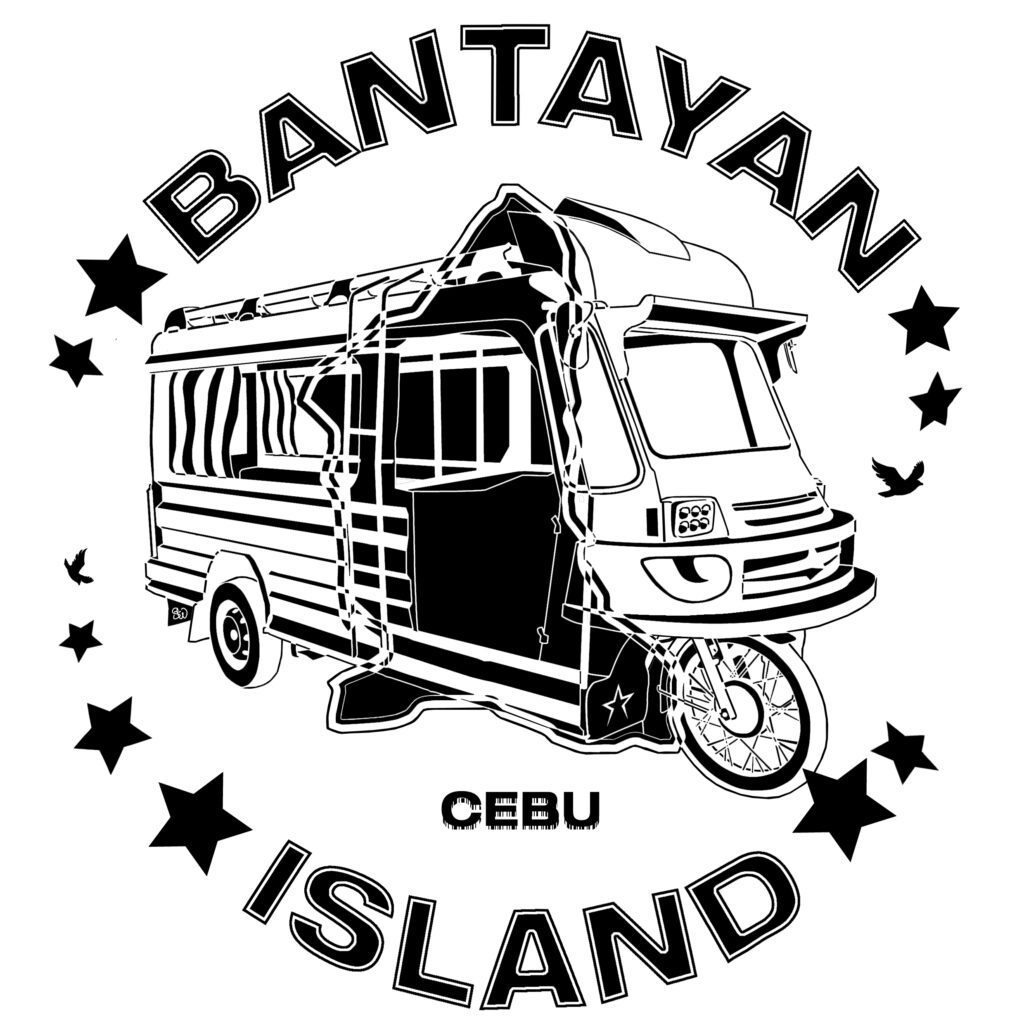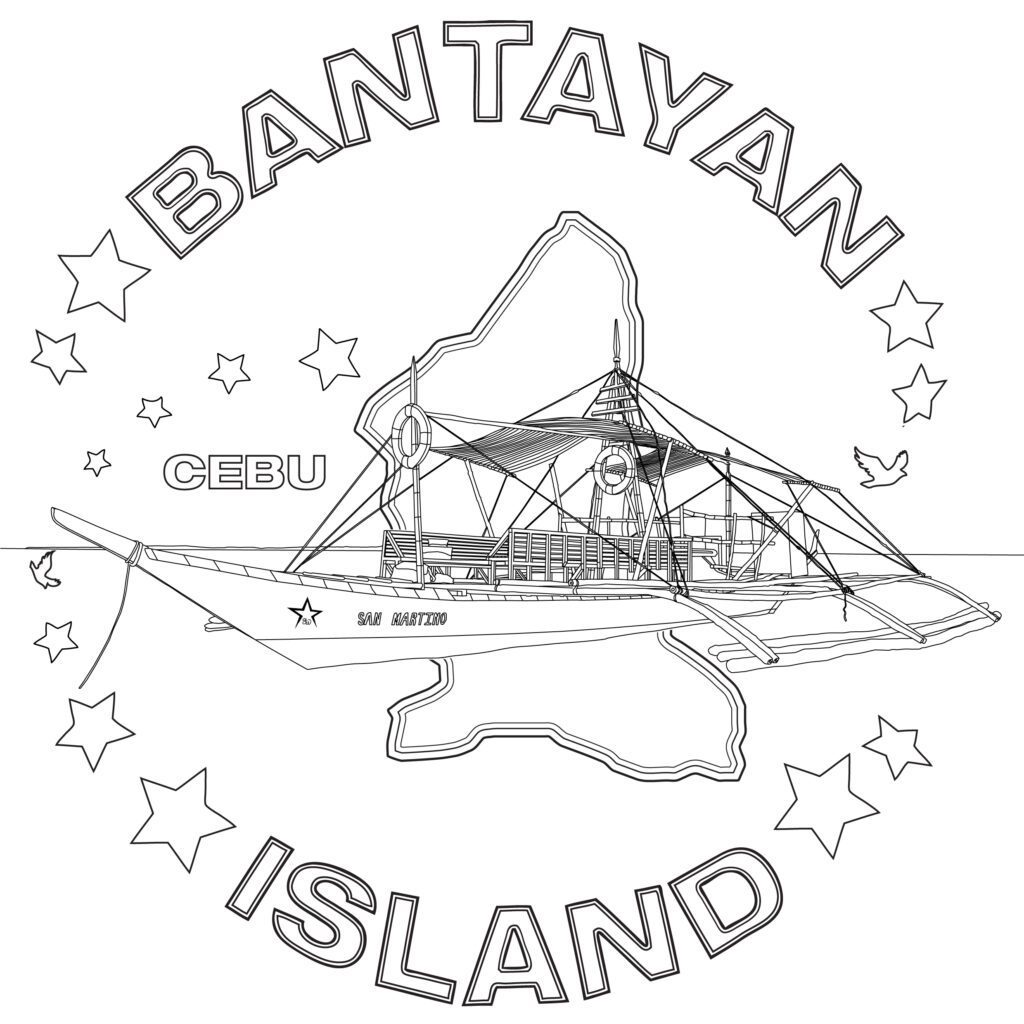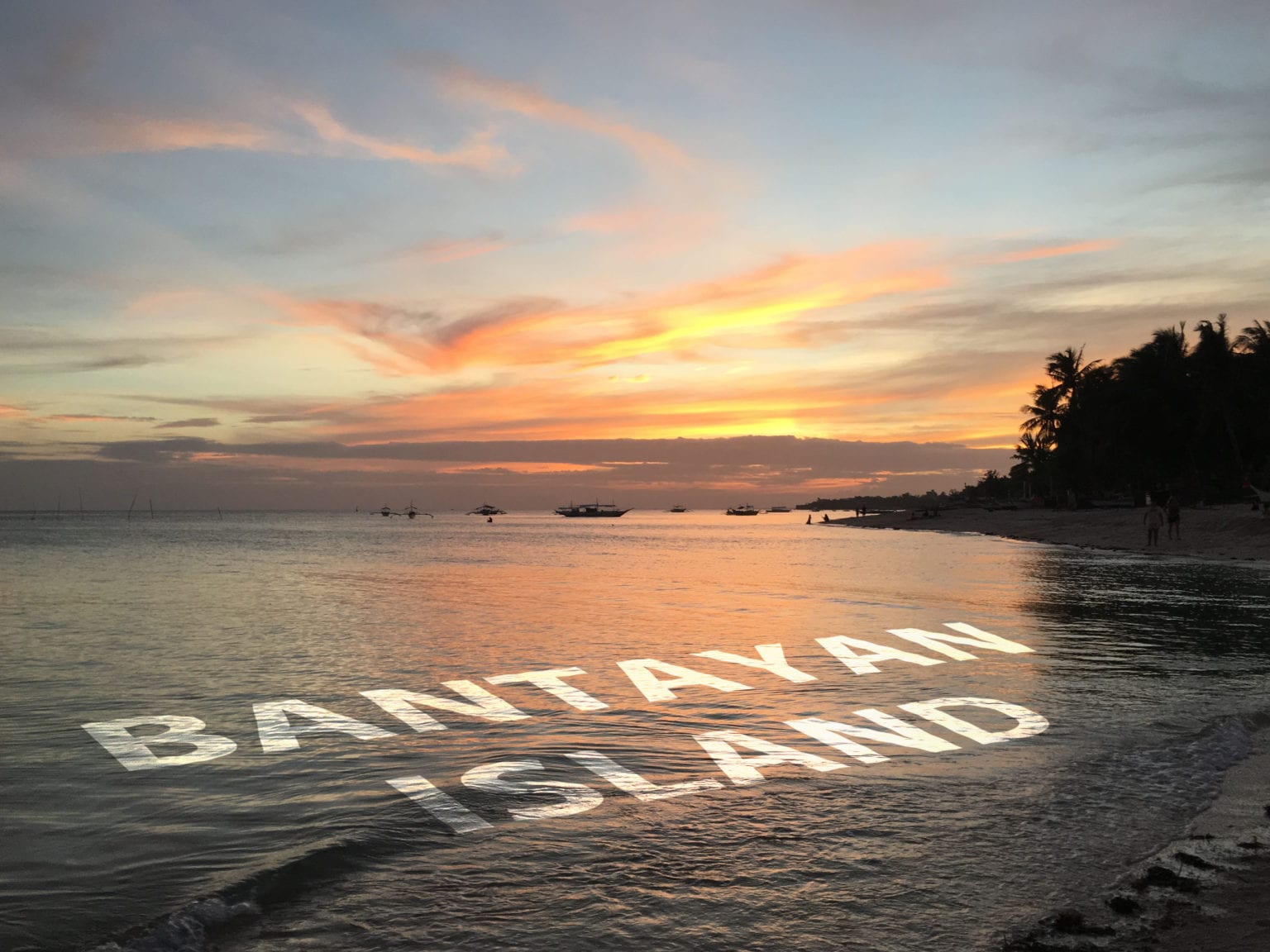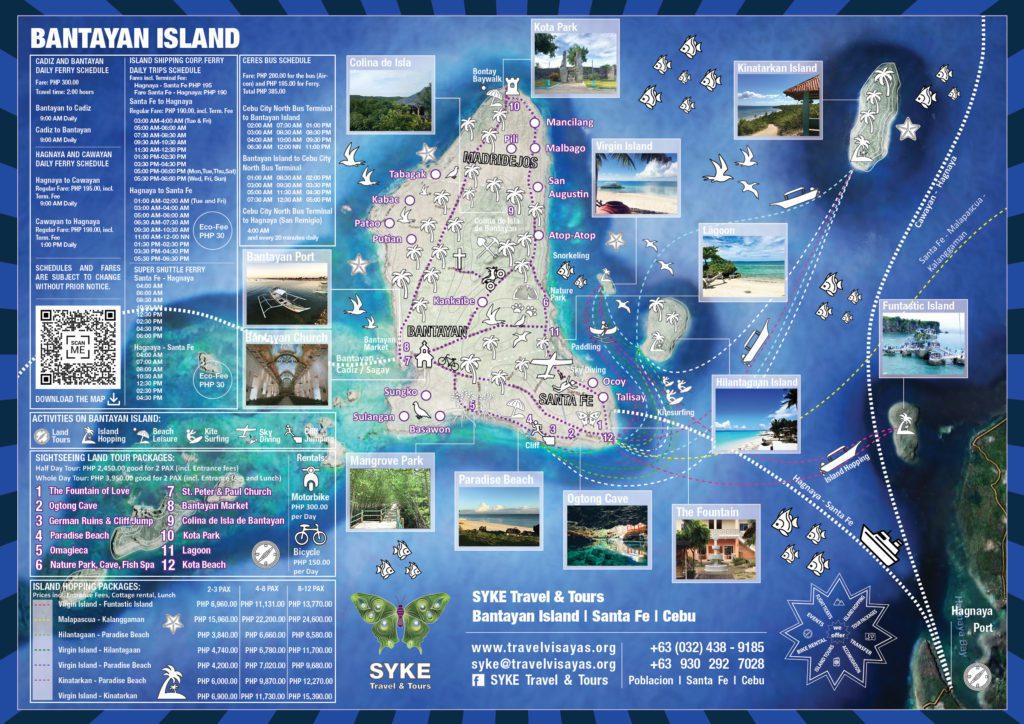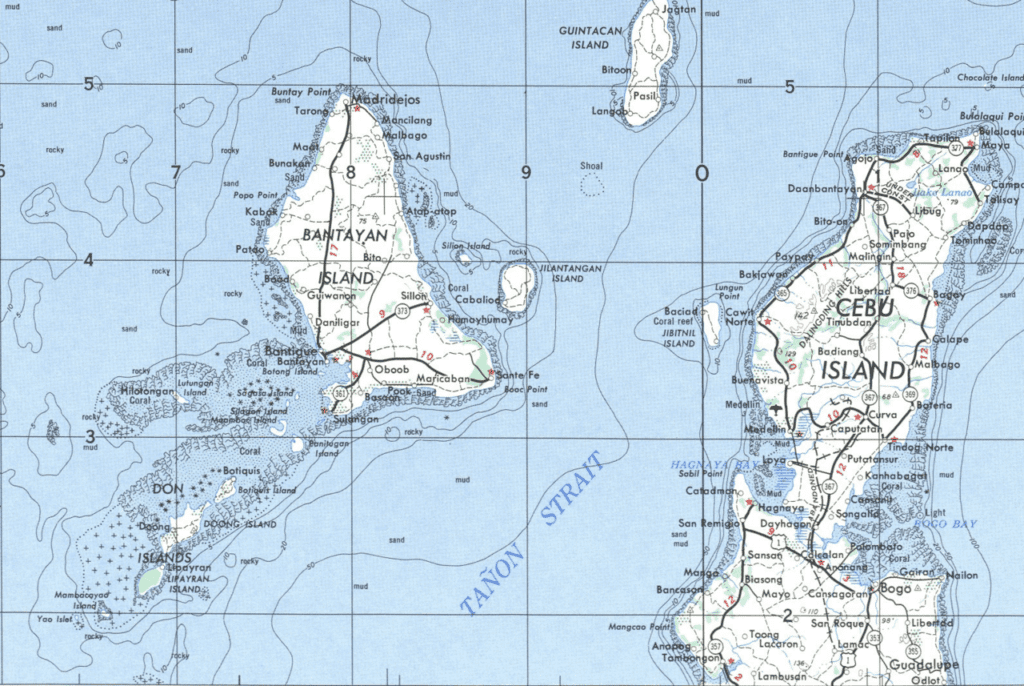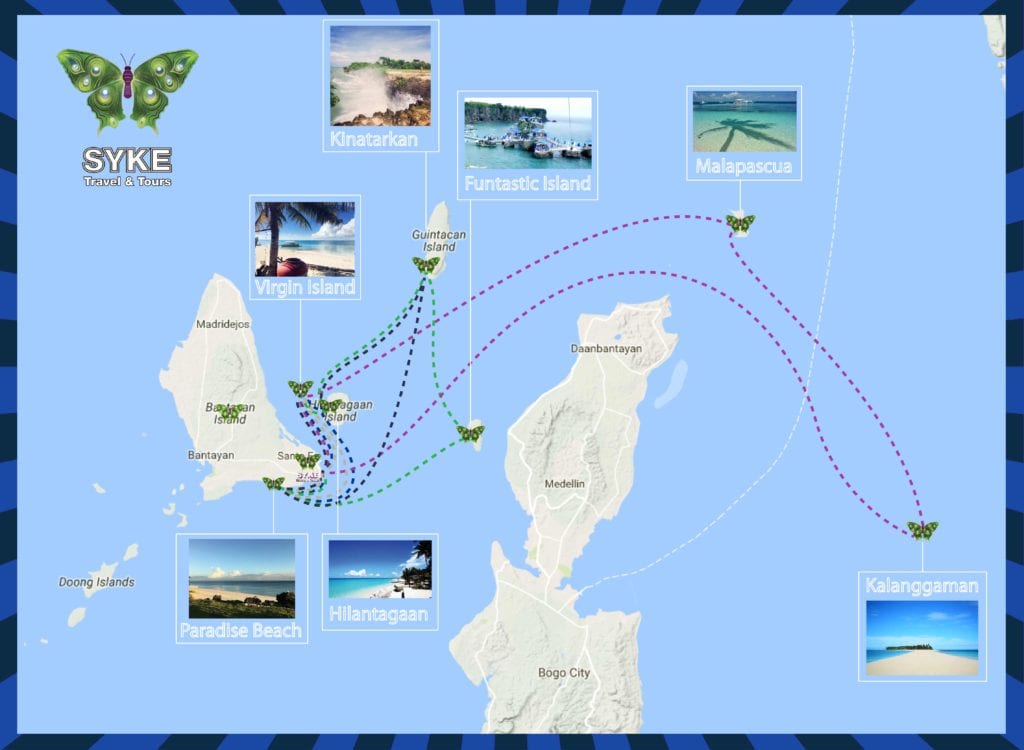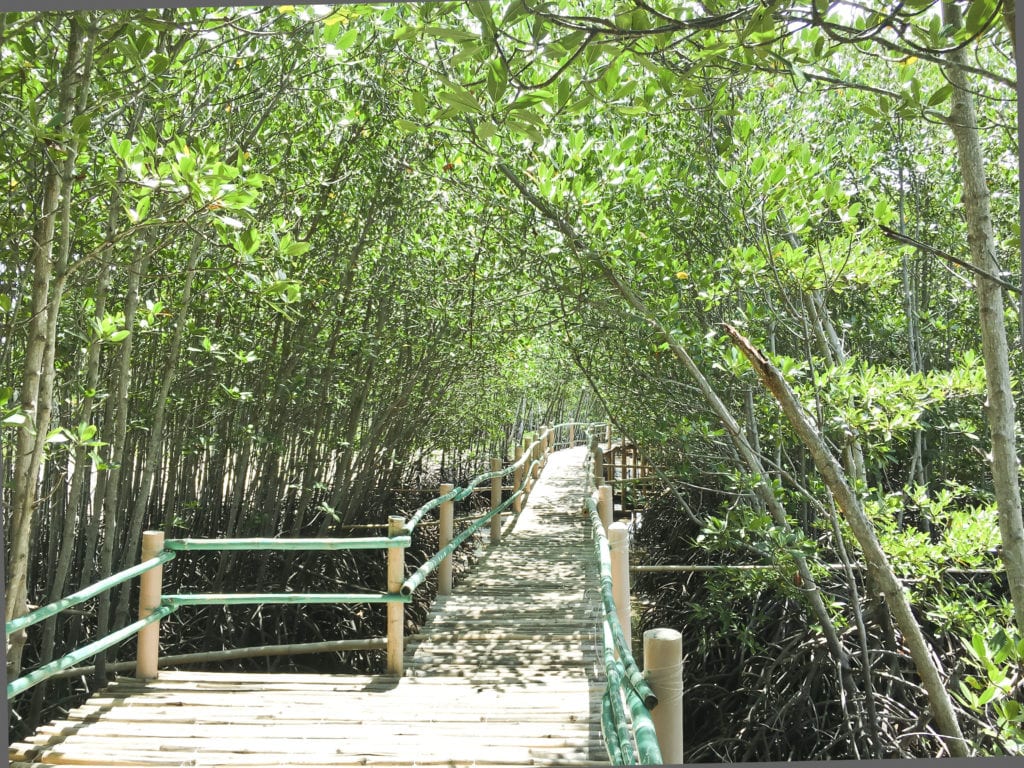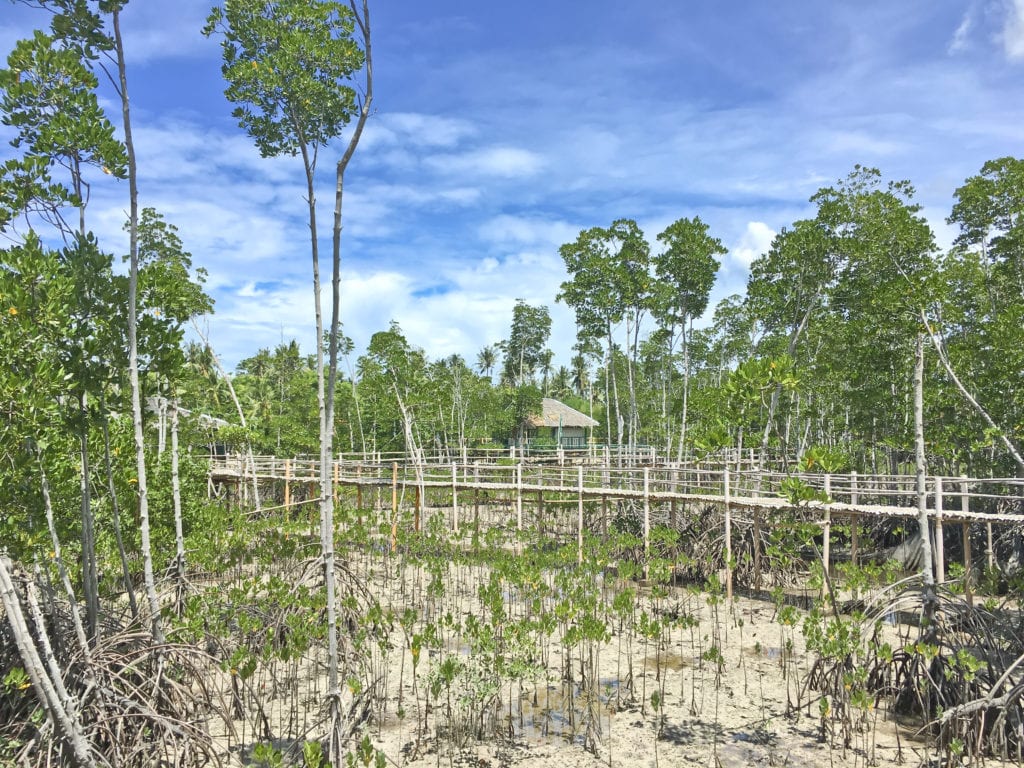ABOUT BANTAYAN ISLAND
Our slogan “Exploring Roots, Finding Heart” implies that searching for the cultural roots of a place can help you find yourself or your better half. The following lines are intended to provide an objective insight into Bantayan Island, derived from internet research and additional input from the experiences of SYKE Travel & Tours.
Table of Contents
Bantayan Island: A Hidden Gem in the Philippines
Bantayan Island is a small island located in the Visayan Sea, off the coast of the northernmost tip of Cebu Island in the Philippines. It is known for its crystal-clear waters, fine white sand beaches, and laid-back atmosphere, making it a perfect destination for travelers looking to escape the hustle and bustle of city life.
Packages Bantayan Island
Experience the enchanting beauty of Bantayan Island with our specially curated travel packages, as enjoyed by the Traveling Chefs themselves. Immerse yourself in the pristine beaches, crystal-clear waters, and vibrant culture of this tropical paradise.
from PHP 18,900 (good for 2 Pax)
A short all-inclusive Getaway to Bantayan Island! Good for weekend travelers, couples, solo travelers or groups who like to enjoy a short vacation including Transfer from Cebu, Accommodation and one Tour on one of the most peaceful islands of Central Visayas. Escape from the busy city life and taste the peaceful and cozy atmosphere of Bantayan Island!
from PHP 22,900 (good for 2 Pax)
A Weekend Getaway to Bantayan Island! Good for weekend travelers, couples, solo travelers or groups who like to enjoy a short vacation including Transfer from Cebu, Accommodation and Tours (island Hopping and Land Tour) on one of the most peaceful islands of Central Visayas. Escape from the busy city life and taste the peaceful and cozy atmosphere of Bantayan Island!
from PHP 27,900 (good for 2 Pax)
For a longer Weekend: An all-inclusive Package to Bantayan Island! Good for couples, solo travelers or groups who like to enjoy a short vacation including Private Transfer from Cebu, Accommodation and Tours (island Hopping and Land Tour) on one of the most peaceful islands of Central Visayas. Escape from the busy city life and taste the peaceful and cozy atmosphere of Bantayan Island!
How to get there
Getting to Bantayan Island is relatively easy. Visitors can take a flight from Manila to Cebu City, which is the nearest major city to Bantayan. From there, they can take a bus or a taxi to the port of Hagnaya, where they can catch a ferry to Bantayan Island.
Attractions and Sights
One of the main attractions of Bantayan Island is its stunning beaches. Santa Fe Beach is one of the most popular beaches on the island, with its powdery white sand and turquoise waters. It is an ideal spot for swimming, sunbathing, and watching the sunset. Other beaches worth visiting include Paradise Beach, Ogtong Cave Resort, and Kota Beach.
Apart from its beaches, Bantayan Island also has other tourist attractions. The Bantayan Church, also known as the Saint Peter and Paul Church, is a must-visit. It is one of the oldest churches in the Philippines and is known for its unique architecture and historical significance.
Activities
For those who love to explore the outdoors, the island has several natural wonders to offer.
Indulge in a variety of activities, from exhilarating skydiving adventures to thrilling kite surfing lessons, all while taking in the breathtaking scenery that Bantayan has to offer. Explore the hidden gems of the island with our guided island hopping tours, visiting picturesque spots like Virgin Island, Hilantagaan, and the serene Balidbid Lagoon.
The Ogtong Cave, for instance, is a natural cave with clear, cool waters that are perfect for swimming. Meanwhile, the Virgin Island is a small island off the coast of Bantayan that boasts pristine beaches, crystal-clear waters, and a breathtaking view of the surrounding sea.
Feast on Flavor: Exploring Bantayan Island's Culinary Delights
Bantayan Island is also known for its delicious seafood. The island’s fishing industry is a major source of livelihood for its residents, and visitors can enjoy fresh seafood dishes at affordable prices. Some of the must-try dishes include kinilaw, a type of ceviche made with fresh fish, and grilled squid.
For places to dine in or take out, whether you’re seeking a romantic dinner or a casual drink with friends, check out the following link:
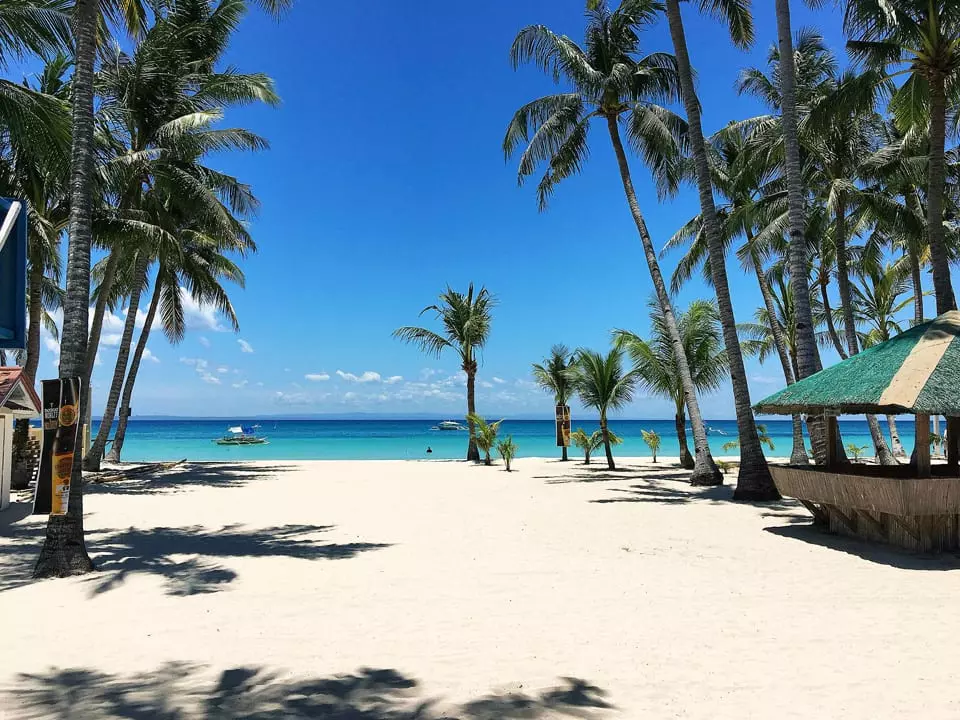


The best place to relax
Finally, Bantayan Island is an excellent place to unwind and relax.
With its serene atmosphere and stunning natural beauty, it is a perfect destination for those who want to escape the stresses of everyday life. Visitors can take a leisurely stroll along the beach, lounge in a hammock, or simply enjoy a cold drink while watching the sunset.
After a day of exploration, unwind and relax in comfort at SMAK’s Hotel, where you’ll enjoy cozy accommodations and warm hospitality throughout your stay.
In conclusion, Bantayan Island is a hidden gem in the Philippines that is definitely worth a visit. With its stunning beaches, natural wonders, delicious seafood, and laid-back atmosphere, it is an ideal destination for travelers looking for a peaceful and relaxing getaway.
What is Bantayan in English? A Quick Guide to Understanding the Meaning
Bantayan is a Tagalog or Visaya word that has its roots in the Filipino language. In English, the word can be translated to mean “watch,” “guard,” or “watch over.” Bantayan can also be used as a verb or a noun, depending on the context in which it is used.
The term bantayan has cultural significance in the Philippines, where it is often used to describe the act of keeping watch over something or someone. This could include watching over a flock of animals, guarding a building or home, or keeping a lookout for potential danger. The word is also used in the context of weight measurement, where it refers to the arm of a balance or the inspector of a weighing scale.
Key Takeaways:
- Bantayan is a Tagalog word that can be translated to mean “watch,” “guard,” or “watch over” in English.
- The term has cultural significance in the Philippines and is often used to describe the act of keeping watch over something or someone.
- Bantayan can also be used in the context of weight measurement, where it refers to the arm of a balance or the inspector of a weighing scale.
Bantayan Defined
Etymology
Bantayan is a Tagalog verb that means “to watch over” or “to guard.” The word is derived from the root word “bantay,” which means “guard.” It is commonly used in the Philippines to refer to the act of keeping watch or guarding something or someone.
Translation
In English, “bantayan” can be translated to “watch,” “guard,” or “watch over.” For example, “Inutusan siya ng hari na bantayan ang kanyang mga kawan” can be translated to “The king sent him to watch over his flocks.”
The Bantayanon language is also closely related to Waray and Hiligaynon, which are other regional languages spoken in the Philippines. Bantayanon is the regional language of the Bantayan Islands in the Philippines, and there are three dialects of Bantayanon based in the three municipalities that comprise the island group: Binantayanun (in Bantayan), Linawisanun (in Madridejos), and Mambakayun (in Santa Fe).
In addition, “bantayan” can also refer to a bamboo bed used for sick people to lie on, or the arm of a weighing scale. It is important to note that the meaning of “bantayan” may vary depending on the context in which it is used.
Overall, “bantayan” is a versatile word that can be used in various contexts in both Tagalog and English.
Cultural Significance
Bantayan Island is a place that is rich in cultural significance. As we learned from our research, the island has a long and storied history that dates back centuries. Over the years, various cultures and peoples have left their mark on Bantayan, resulting in a unique blend of traditions and customs.
One of the most significant cultural landmarks on Bantayan Island is the Saint Peter and Paul Parish Church in Bantayan Town. This charming old church is a testament to the island’s deep Catholic roots and is a popular destination for both locals and tourists alike. The church’s architecture and design are truly impressive, and I highly recommend taking the time to explore it if you find yourself on Bantayan Island.
Another interesting aspect of Bantayan’s cultural significance is its commitment to preserving its traditions and history. I learned that the island has a strong sense of community and pride in its heritage, which is evident in the many festivals and celebrations that take place throughout the year. For example, the Bantayan Festival is a reenactment of the struggle of the people of Guimbal, and it is celebrated every March 9-15. The festival is a tribute to the ancestors of the people of Guimbal and is a testament to the island’s rich cultural history.
Overall, Bantayan Island is a place that is steeped in cultural significance and history. From its impressive churches to its vibrant festivals, there is no shortage of things to see and do on the island. If you’re looking for a unique and enriching cultural experience, I highly recommend a visit to Bantayan Island.
Frequently Asked Questions
How do you translate ‘bantayan’ to English?
‘Bantayan’ can be translated to English as ‘to guard’ or ‘to watch over’.
What’s the English pronunciation of ‘bantayan’?
The English pronunciation of ‘bantayan’ is ban-tah-yahn.
In terms of grammar, how is ‘bantayan’ used in English?
‘Bantayan’ is commonly used as a verb in English. For example, “I will bantayan the house while you’re away.”
What’s the English equivalent of ‘kailangan bantayan’?
The English equivalent of ‘kailangan bantayan’ is ‘needs to be guarded’ or ‘needs to be watched over’.
What are some synonyms for ‘magbantay’ in English?
Some synonyms for ‘magbantay’ in English are ‘to protect’, ‘to safeguard’, ‘to monitor’, ‘to observe’, and ‘to keep an eye on’.
Can you explain the meaning of ‘bantay’ in English?
‘Bantay’ can be translated to English as ‘guard’, ‘watchman’, or ‘sentinel’. It refers to a person or thing that is responsible for protecting or watching over something.
Key Figures
Bantayan Island is an island located in the Visayan Sea, Philippines. It is situated to the west of the northern end of Cebu island, across the Tañon Strait. According to the 2015 census, it has a population of 162,757.
The island is administratively divided into three municipalities:
– Bantayan (the largest municipality, covering the central part)
– Madridejos (covering the northern portion)
– Santa Fe (center of tourism in Bantayan Island, covering the southeastern portion)
The island area is 108.77 square kilometres (42.00 sq mi). The island is mostly covered with coconut palms; the elevation is mostly below 10 metres (30 ft), with only one taller hill, at 26 metres (90 ft), in barangay Atop-atop.
Island Group
Bantayan is the main and largest island of the Bantayan island group that lies close to the geographical centre of the Philippine archipelago.
The island group includes numerous smaller islands (some uninhabited or uninhabitable), mostly around the southwest corner of the island. About 20 of these islets stretch for about 8 kilometres (5 miles) southwest from Bantayan municipality port area, with some nearer ones being accessible on foot from the main island at low tide. The islands are beside the busy shipping lanes for ships and ferries coming from Mindanao or Cebu City on their way to Manila. The islands are all small and green and low, virtually indistinguishable one from another.
Some of the more notable are:
Botique (or Botigues, Batquis)
Botong
Byagayag Islands (Daku and Diot)
Doong
Hilantagaan (or Jicantangan, Jilantagaan, Cabalauan)
Hilantagaan Diot (or Silion, Pulo Diyot (little island))
Hilutungan (or Hilotongan, Lutungan)
Lipayran
Mambacayao (or Mambacayao Daku)
Moambuc (or Maamboc, Moamboc, Kangka Abong, Cangcabong)
Panangatan (or Pintagan)
Panitugan (or Banitugan)
Patao (or Polopolo)
Sagasay (or Sagasa, Tagasa)
Silagon
Yao Islet (or Mambacayao Diot)
In addition, Guintacan Island (or Kinatarkan, Batbatan) to the northeast is part of Santa Fe municipality although it is not part of the Bantayan islands group archipelago.
Demografics
Population of Bantayan Islands combined:
Year Pop. ±% p.a.
1903 20,476 —
1918 24,271 +1.14%
1939 35,288 +1.80%
1948 50,209 +4.00%
1960 56,851 +1.04%
1970 69,926 +2.09%
1975 78,189 +2.27%
Year Pop. ±% p.a.
1980 82,363 +1.05%
1990 106,584 +2.61%
1995 110,486 +0.68%
2000 120,101 +1.80%
2007 129,154 +1.01%
2010 136,960 +2.16%
2015 162,757 +3.34%
Language
The Bantayanon language is mostly a mixture of different neighbouring Visayan languages: The principally native Cebuano (from Cebu and Eastern Negros) and Hiligaynon (from Western Negros and Iloilo), Boholano (from Bohol), Masbateño (from Masbate) and Waray-Waray (from Leyte and Samar). However it has its own words such as “kakyop” (yesterday), “sara” (today) and “buwas” (tomorrow).
Climate
Average temperature in Bantayan island is 28·0°C, the Humidity 75–85%.
The climate is typically equatorial – temperature range over the year is less than three degrees Celsius (5.4 deg F), and annual rainfall exceeds 1,500 millimetres (59 in). January to April inclusive are less wet than the other months. This supports at least two rice crops per year. The climate in Bantayan falls within Coronas climate type IV, characterised by not very pronounced maximum rainfall with a short dry season from one to three months and a wet season of nine to ten months. The dry season starts in February and lasts through April sometimes extending to mid‑May.
Bantayan has a tropical climate. Most months of the year are marked by significant rainfall. The short dry season has little impact.
National protected areas
Bantayan and its surrounding islands have been included in several pieces of legislation giving protected status.
Wilderness area
In 1981 President Marcos signed proclamation no. 2151 giving certain parts of the country protected status. This included Bantayan Island with the status of a “Wilderness Area”, although its physical extent was undefined, albeit the proclamation described all the areas named as “containing an aggregate area of 4,326 hectares, more or less”. Eleven years later the Philippine Congress passed Republic Act 7586 – the National Integrated Protected Areas System (NIPAS) Act of 1992, managed by the Department of Environment and Natural Resources (DENR) – which reaffirmed the protected status. However it too did not specify the extent of Bantayan Island Wilderness Area (BIWA), which is therefore taken to include the whole island group, more than 11,000 hectares.
After 2013’s Typhoon Yolanda, there has naturally been a need and desire for reconstruction, however one major problem is that because of the designation, there is little land titling, and international relief organisations (and others) are reluctant to fund construction on land where title does not exist. 2014 has seen the start of initiatives to define the area, and to devise a general plan for its management (BIWA-GMP). That plan recommends retaining only 596.41 ha (1,473.8 acres) as strictly protected wildlife reserves, or 5.3% of the original BIWA, and allowing multi-use zoning of 10,648.27 ha (26,312.4 acres). From that has arisen a more concrete proposal regarding reclassification. Now the plan is to be recommended to Congress.
Tourist zone and marine reserve
Presidential proclamation no. 1801 of 1978 established Tourist zones and marine reserves, and placed the island of Hilutungan within its scope.
Protected seascape
The Tañon Strait protected seascape was established by President Ramos under proclamation no. 1234 of 1998. This includes more than 29,187 m (29 km; 18 mi) of the eastern shoreline of Bantayan island. In February 2015, 17 years after its declaration, the first summit on the Tañon Strait protected seascape is to be held.


Agriculture
The dominant uncultivated vegetation is ipil-ipil (Leucaena leucocephala). Cultivated crops include coconut, cassava, banana, sugarcane, corn and mango.
The Sea
The coast of Bantayan and its islands mostly alternates between mangal and palm trees. Because of the shallow slope on the shelf, the intertidal area can be quite extended, leading to rocky and muddy shallows at low tide. This means that places with a sandy shore – a beach – are infrequent. Good beaches can be found in the southeast around Santa Fe, and in the northwest at Patao and Madridejos. Even these though are not cleaned, and depending on the currents there can be considerable amounts of flotsam and jetsam on the beach and in the sea.
Coral
Bantayan Island became famous for its craft works with corals and shells in the second half of the 20th century. Meanwhile it is forbidden to produce or sell those artworks, that’s why this Industry disappeared.
Of the approximately 500 varieties of coral known worldwide, about 400 are found in the Philippines. However their future is seriously threatened – mainly due to destructive fishing techniques, such as blast fishing and cyanide fishing, which indiscriminately destroy much of the ecosystem, including the coral reefs. In addition, global warming and ocean acidification also contribute significantly to worldwide loss. Globally coral sees 50%–70% threatened or lost; southeast Asian coral reefs are in even worse condition, and it is estimated in the Philippines the figure under threat is greater than 90%, with less than 1% in good condition. Until now proper compliance of international laws has been poor, although it is starting to be taken seriously. Meanwhile, other efforts are under way in Bantayan to accelerate the regrowth, using coral farms.
Starfish
There are many starfish to be seen in the intertidal area. Their detrivorous diet helps keep the water clean. Further out though, the crown-of-thorns starfish is a considerable threat to the coral reef, because of its voracious hunger for the coral.
Mangal
Mangroves are salt-tolerant, woody, seed-bearing plants that are found in tropical and subtropical areas where they are subject to periodic tidal inundation. The Philippines has over 40 species of mangroves and is one of the most biodiverse regions in the world as there are only about 70 species of mangroves worldwide. The mangrove ecosystem is a very diverse one and is home to many birds, fish, mammals, crustaceans and other animals.
Mangroves provide an important nursery for fish, shellfish and other organisms. It is estimated that each hectare of mangrove can provide food for 1,000 kg of marine organisms (890 lb/acre). With this abundance of food for fish present in the mangroves, each hectare of mangal yields 283.5 metric tons of fish per year (112.9 long ton/acre). Mangroves also provide other important functions such as preventing soil erosion and protecting shoreline from typhoons and strong waves. Mangroves provide many other products and services such as medicines, alcohol, housing materials and are an area for research and tourism.
However even with all of these known benefits the state of mangroves within the Philippines is very dim. In the early 1900s there were approximately 5,000 km2 (1,900 sq mi) of mangroves but today there are only about 1,200 km2 (460 sq mi). Many of the mangrove areas were destroyed to make way for fishponds and reclamation areas. They were used indiscriminately for housing – both building materials and reclamation – and were disturbed by siltation and pollution.
Now that the true benefit of these ecosystems is known there is protection and rehabilitation of these important ecosystems. It is now illegal to cut down mangroves for any purpose and local governments and community organizations have taken active roles in planting and managing mangrove plantations. There is hope that in the future mangroves will return to the healthy status that they once held.
History
Early Origins
There are almost no physical records nor evidence to indicate when the first people came to Bantayan, nor their places of origin. Some believe they can be traced back to Panay, others believe that the bulk of them were of Cebuano origin, and still others say they came from Leyte and Bohol according to the local dialects and family names. Some think that the first people coming to the Island have been escaping from the Moro Rage. The people were timid, knew little about placees away form home and wore scanty clothing due to warm temperature.
Connections between Bantayan and other places can be deduced from the mixed dialects spoken by the people, and their ancient culture such as cloth‑weaving, dance, and architecture. In addition certain old-established Hispanic family names are associated with certain locations:
Panay: Rubio, Arcenaz, Alvarez, Sevilleno
Cebu: Rodriguez, Ancaja, Mansueto, Villacrucis
Leyte: Villacin, Villaflor, Ortega, Carabio
Bohol: Hubahib, Garcia, Caquilla
Paraguay: Nepanggus, Nepangue
There is little documentary evidence of life and culture before the arrival of the Spanish conquistadores. What we know of them is gathered from handed-down accounts and folklore.
The early people were said to be timid. They did not travel and knew little of places away from their homes. They wore little clothing because the climate did not need it. The abundance of fish, wild game, wild fruits and tuber, such as ba-ay, hagmang,bailacog, and kiot, made the people do little more than make clearings on which to plant corn, camote (sweet potato) and other vegetables. Large and small trees grew and spread, shading the ground all year round with their heavy foliage. Vines and creepers climbed the trees hanging from bough to bough; cultivation of open land was difficult.
The Spanish Period
Early Years
During the period 1565–1898 the Philippines was a Spanish colony, part of the Spanish East Indies.
The parish church was established in 1580 – as an encomienda of the heir of Don Pedro de Gamboa.
Writing in 1582, Miguel de Loarca stated:
ysla de bantayan. A la vanda del norte de a ysla de çubu apartada della como dos leguas esta la ysla de bantayan que terna oçho leguas de box y dos de ançho tiene çerca de mil yndios y son de vn encomendero ella y la ysla de Vohol aRiba diçho, la gente della es buena gente tratante tienen grande pesquerias que es ysla de heçha muçhos baxos tiene pesqueria de perlas aunqe poca cosa no se coje en ella sino a Millo y borona y no se coje ningun arroz por ques tierra toda de mal pais aunque llana algunos de los naturales desta ysla haçen sus sementeras en la ysla de çubu, como digo esta dos leguas de trauesia tiene muy buenos palmares y lo mismo se a de entender de todas las yslas de los pintados porque todas lellas abundan en gran cantidad de palmas.
Island of Bantayan. “About two leagues north of the island of Çubu lies the island of Bantayan. It is about eight leagues in circumference and two leagues wide, and has a population of about one thousand Indians; this and the above-mentioned island of Vohol are under the charge of one encomendero. Its inhabitants are well-disposed. They have large fisheries, for there are many shoals near the island. There is also a pearl-fishery, although a very small one. The land produces millet and borona, but no rice, for all the island has poor soil notwithstanding that it is level. Some of the natives of this island cultivate land on the island of Çubu, which, as I have said, is two leagues away. The island abounds in excellent palm-trees — a growth common to all the Pintados islands, for all of them abound in palms.”
He also wrote:
Otra manera de esclauonia. Ay otro genero de señorio qe yntroduxo Vno que se llamaua sidumaguer qe Diçen que a mas de dos mill años qe fue que porque le quebraron vn barangay en languiguey donde el era natural ques En la ysla de bantayan qe si tenian los qe defienden, de Aquellos qe le quebraron el barangay si qdo mueren dexan diez esclauos le dauan dos y Al Respeto toda la demas haçienda, y esta manera de esclauonia. quedo yntroduçida en todos los yndios de las playas y no los tinguianes.
Another kind of slavery. “There is another kind of lordship which was first introduced by a man whom they call Sidumaguer — which, they say, occurred more than two thousand years ago. Because some men broke a barangay belonging to him — in Languiguey, his native village, situated in the island of Bantayan — he compelled the descendants of those who had broken his barangay to bequeath to him at their deaths two slaves out of every ten, and the same portion of all their other property. This kind of slavery gradually made its way among all the Indians living on the coast, but not among the Tinguianes.”
Writing in 1588, Domingo de Salazar reported: “The island of Bantayan is small and densely populated. It has more than eight hundred tributarios, most of them Christians. The Augustinians who had them in charge have abandoned them also, and they are now without instruction. This island is twenty leagues from Zubu.”
Some time in 1591, Bantayan’s population totalled 683 tributes representing 6732 persons.
Writing in 1630, Fray Juan de Medina noted: “Religious were established in the island of Bantayan, located between the island of Panay and that of Sugbú, but farther from that of
Panay. However, if one wishes to go to the island of Sugbú without sailing in the open sea, he may coast from islet to islet, although the distance across is not greater than one or one and one-half leguas. These Bantayan islets are numerous, and are all low and very small. The largest is the above-named one. When Ours acquired it, it had many inhabitants, all of very pleasing appearance, and tall and well-built. But now it is almost depopulated by the ceaseless invasions from Mindanao and Jológ.”
He goes on to say: “This island has a village called Hilingigay, which it is said was the source of all the Bisayan Indians who have peopled these shores, and whose language resembles that of Hilingigay.”
From 1635-1644, the Visayas were harrassed by the Moros. Stone walls and watchtowers were built throughout the Island-group for refuge and protection. Watchtowers were locally known as “Bantayan sa Hari” meaning “Watchtowers of the King”. In the course of their vigil after the Moros, it became a common expression for islanders to say “Bantayan, Bantayan” meaning “keep watch, keep watch”. This is how the island got his name, the watchtower ruins remain especially in the north of Madridejos and on Doong Island, part of the western archipelago.
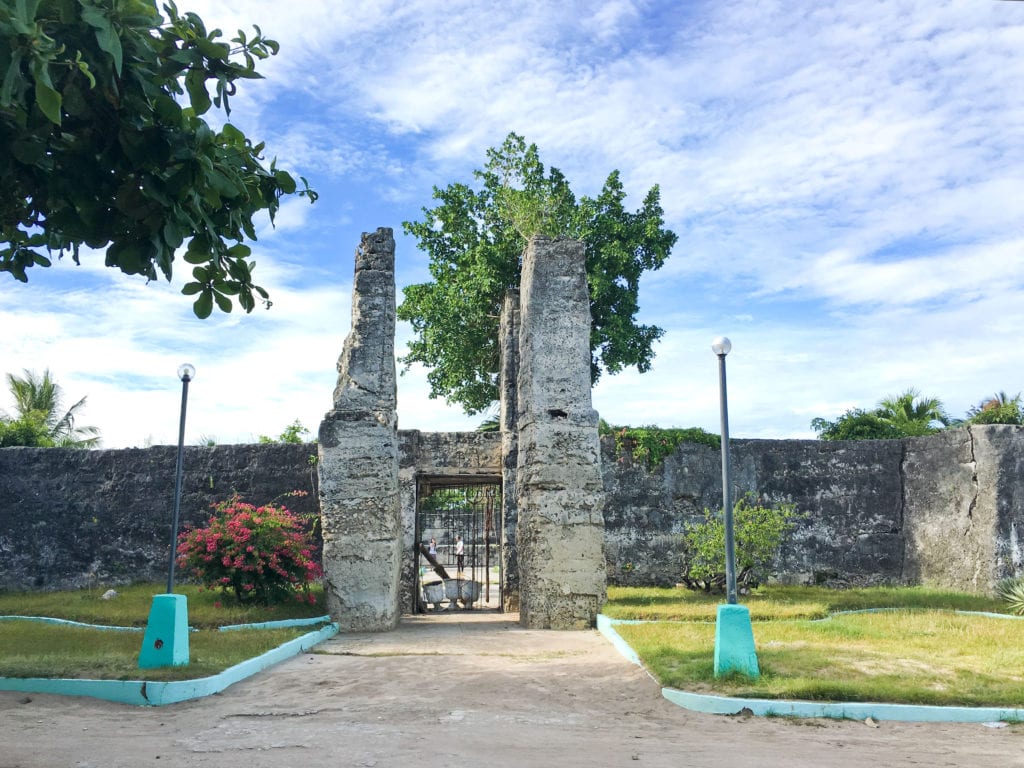



Our latest line of souvenir items just rolled out and they feature the stunning Bantayan Island! Not only will they remind you of the breathtaking views, but they also make for unforgettable keepsakes. From handcrafted lamps to awesome t-shirts, there’s something for everyone!
Derivation of name
During the time of 22nd Governor-General Sebastián Hurtado de Corcuera, the Visayans were continually harassed by Moro pirates who came on raids to capture slaves. Consequently, tall stone walls and watchtowers were built in different parts of the archipelago, for refuge and protection from Moro aggression.
Popular folklore says that these watchtowers were known locally as “Bantayan sa Hari”, meaning “Watchtowers of the King”, and they served as lookout towers for incoming vintas (Moro pirate vessels). In the course of their vigil, it became common to say, “Bantayan! Bantayan!”, meaning, “Keep watch! Keep watch!”, and that was how this island-group got its name.
However Madridejos history scholar Eng’r. Brient Mangubat who have studied Bantayan Island History and the Lawis Old Fort foundation in Madridejos claimed that the origin of the Island’s name Bantayan have nothing to do with the Muslim raiders
according to him the Island got its name (Bantayan) way back in year 1574, when the Island’s northern side (LAWIS), was used as a” Lookout post” after Da-an Bantayan to monitor the Visyan Sea against Chinese, as Manila the country’s capital city was under attack by the forces led by Limahong. and the Island’s name (Bantayan) was already used 25 years earlier, before the (first) Muslim raid took place on Bantayan Island in year 1600.
In all there were 18 watchtowers built on the Bantayan islands. Most have not survived, although relics can be seen to this day. That at Madridejos is in fair condition, that at Santa Fe less so. There is a particularly fine example on Doong island.
In his “Statement of the Annual Incomes and Sources of Profit of His Majesty in These Philipinas Islands” for the year 1608, Pedro de Caldierva de Mariaca declares the tributes (tax) from Bantayan and Bohol combined amount to 2400 gold pesos.
Industry
Don José Basco y Vargas was Governor-General of the Philippines from July 1778 until September 1787. During his period in office, he pioneered many projects for the encouragement of agriculture and industries. However many small industries in the islands were completely abandoned because the people were forced to work on building roads, public buildings and churches. Those enforcing were called politas.
The abundance of fish, favourable climate and virgin soil then greatly determined the occupation of the people. These geographical factors became strong stimuli for the people to be fishermen, farmers and sailors. Much later, the small clearings were expanded to fields.
The old Spanish roads connecting Santa Fe, Bantayan, and Madridejos were constructed chiefly through the services of labour and partly supported by the tribute funds.
Religion and Education
When the Spaniards came to Bantayan, the people already had some form of religious convictions and worship, such as animism, shamanism, evocation and magic. They easily conceived the idea of evil spirits, good spirits, witches and ghosts. In order to please these imaginary creatures people often resorted to charms, vows, sacrifices and self-harm. It was a common belief among the illiterate people of the past that cholera and other fatal diseases were caused by poison which an evil spirit had put into the wells and that the people could be saved from the dreaded disease only by chanting prayer and holding processions.
In just a few years the islanders converted to Christianity because of the piety and devoted life by the early missionaries to the island. The first Spanish schools, one for boys and one for girls, were built in 1864. Construction of the present Catholic church in Bantayan began in 1839 and ended in 1863. In 1891, the barrio of Ticad burned to the ground. Famine from 1879 to 1896 forced natives to eat “amorsico” a growth on the walls of their nipa huts.
The cooperation between the church and the state did not last very long. Quarrels between the church and the state ensued. There was struggle for political power, from the Governor-General down to the alcalde mayors on one hand and from the archbishop to the friars on the other. Because of this, projects for improvements were all paralysed.
The American Period
On 4 January 1899, following the defeat of Spain in the Spanish–American War, a new government was born to the Philippines. With instructions from President McKinley, General Otis, who commanded the US Army in the Philippines, declared that the American sovereignty must be recognized without condition. This was the beginning of the American period.
This island-group did not taken any active part in the revolution against Spain or America. However, after the Filipino–American War, a reactionary group was organized, headed by Patorete of Santa Fe, then still a barrio of Bantayan. Their announced purpose was to resist the invaders, but the armed goons carried a campaign of terror burning the northern part of Santa Fe, plundering and forcing Capitan Miroy and Aguido Batabalonos to join them. This resulted in great fear and tension among the inhabitants.
The condition of the barrios, after the overthrow and immediately preceding the arrival of the Americans, in general, was very far from satisfactory. Sanitation was entirely a stranger; barrio life was dreadful. There were few signs of improvement among the people since their primitive ancestors.
The subdivision of the province of Cebu was developed utilizing the method introduced by Spain. A new provincial law had been enacted in 1895 and necessary appointments were then made. At that time, Bantayan was already organized as pueblo. Santa Fe was organized as such in 1911 and Madridejos in 1917. These pueblos were given a new corporate form under the Municipal Council chosen by a limited native electorate. For the local head of the administration, the title Presidente took the place of the former Gobernadorcillo or Capitan.
Committed to the task of administering the newly organized municipal governments were the first presidentes of the three towns comprising the island-group namely: Gregorio Escario for Bantayan, Vicente Bacolod for Madridejos and Casimiro Batiancila for Santa Fe. Political parties were formally organized since the early days of the American regime. Partido Liberal came towards the end of 1900. Pascual Poblete founded the Partido Independista in 1902.
During the administration of Governor-General Luke E. Wright (1904–1906), the public road policy was inaugurated. Little by little the stage trails were changed to roads of more durable construction. Late in 1913 the construction of Santa Fe—Bantayan road began and in 1918 the Bantayan—Madridejos road followed; both were completed in 1924.
Then and now, fishing and farming were important industries of the people, but from the year 1903 to 1925, weaving of piña cloth and the gathering of maguey fibre were very lucrative pursuits of the people. Over the years demand for these products weakened and died out. At about the same, hand embroidery termed as “spare time industry” came in. A good number of women adopted it and were actively engaged in it for some years. The local output was quite significant. In 1923, because of weak and unsettled market conditions, particularly in Manila, the business gradually disappeared.
Independent Philippines
Gregorio Zaide described the Philippine national characteristic as “pliant, like bamboo, bending in the wind without breaking”. This might explain the war-time actions of the then mayor Isidro Escario, who had himself rowed out to meet a fleet of Japanese warships where he treated with them: Bantayan was not invaded and the war basically passed it by.
Heritage
Here are a few historically notable buildings but they have generally not been well maintained, and the ravages of the climate hasten decay, together with several major fires, which consume the wooden structures. Preventive maintenance generally was not practised, so even the best preserved buildings date back only to the middle of the 19th century.
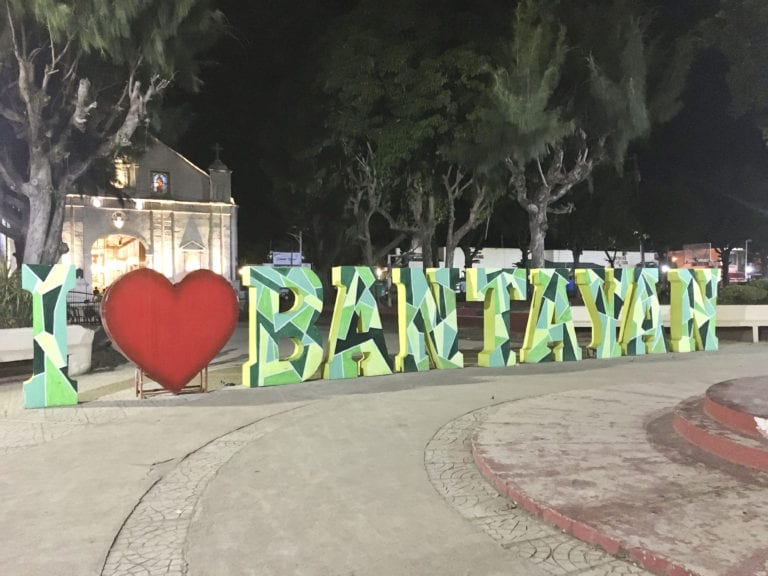

Houses
Central plaza was the location of several well-built houses. Opposite the church Manuel del Rosario built two which used to be “the grandest homes on Bantayan island”. Originally pre-dating the church, one was used as the Casa de Mamposteria (house of masons) during construction of the church. The main house was later inherited by the son of del Rosario and his second wife, while the house next door was their wedding gift to their daughter.
After subsequent bequests, ownership of both houses was shared by many scions of the Causing and Escario families. They were unable to decide on (or maybe fund) any necessary preventive maintenance work. As at February 2013 both houses have more or less collapsed in ruins past repair. All that remains of Bantayan’s former glory is a dangerous and unsightly collection of rotten beams, collapsed walls and broken tiles occupying a prime and valuable location. Typhoon Yolanda subsequently caused both ruins to collapse entirely.
Parish church of Sts Peter and Paul
The main church stands on the principal plaza. Since the arrival of the Spanish there have been several buildings on its site: originally it was little more than a bamboo and nipa structure, which was burned down during one of the Moro raids. This was replaced by another wooden structure, which also burned down. Construction of the present building (the fifth on the site) started in 1839. The main driving force was the parish priest Padre Doroteo Andrade del Rosario and the maestro de obras (master of works) was his nephew Manuel Rubio y del Rosario (also known as Kapitan Tawi). Construction lasted about 24 years. The principal building material is coral, sawn to approximately parallelepiped shape and dressed like stone.
Since mid–2012 refurbishment work has been in progress: the belfry has been restored to its former glory, and as at February 2013 there are plans to open it for tourist access. The stairs are very steep and not very well guarded, however it does offer an elevated panoramic view of the waterfront. In 2020 the refurbishment works inside and outside have been completed.
The church also houses a small museum, visiting by appointment.
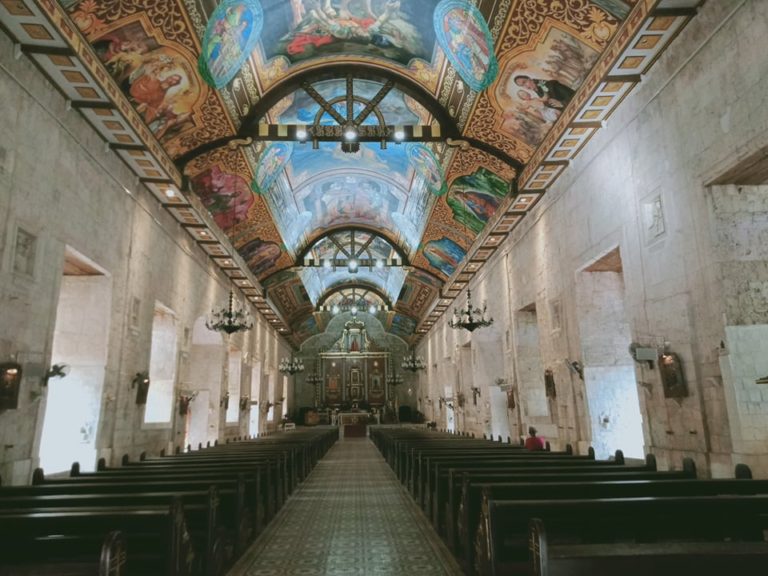

The Fountain of Love
The Fountain of Love and the garden surrounding it, were implemented during the pandemic crisis of COVID-19 in the months of May to September 2020. The fountain was the central project during the months of crisis and is the result of the great teamwork and the combination of the skills of the staff of SYKE Travel & Tours and SMAK’s Hotel & Restobar. Its structure and shape were created by handmade moulding and using only locally available materials and techniques.
The fountain stands as an expression of the will to fight against the economic and social depression caused by the COVID-19 crisis on Bantayan Island, while at the same time creating a new part of its cultural heritage. And all of this was created by people who represent the class of residents who suffered the most in those days. It was not the only project in these months and it will not be the last one in this time.
Last but not least it is dedicated to the One and Only, but remains open to all its visitors who will find their love or have already found it.
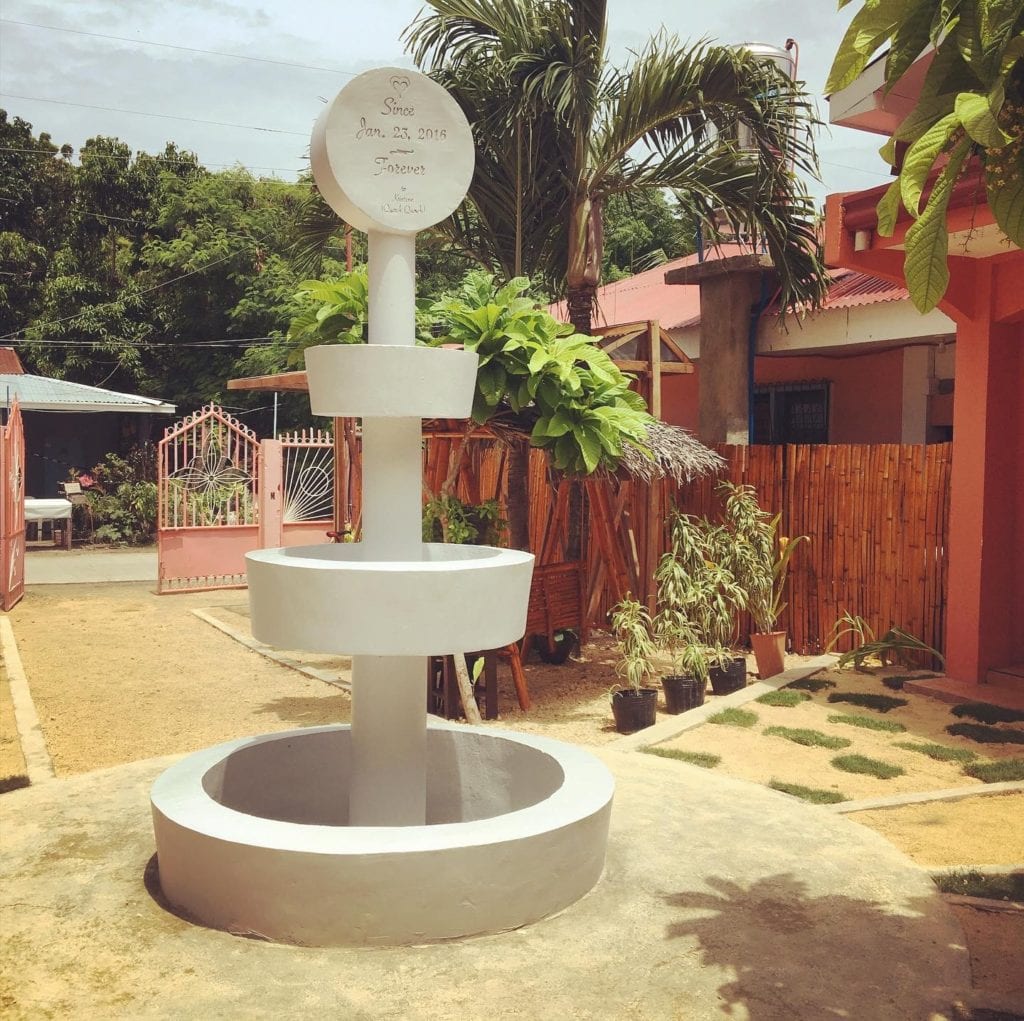

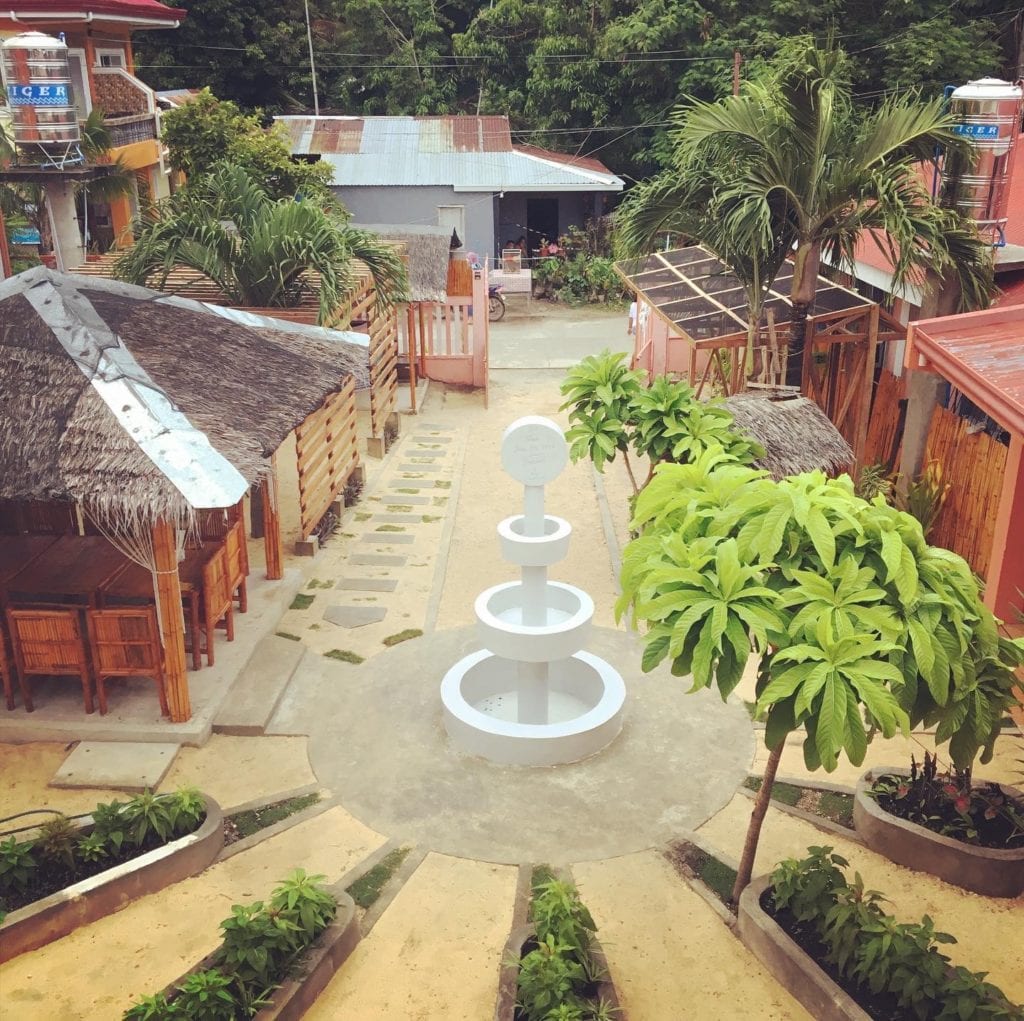

Architecture & Design:
Stefan Welter (SWELTER Ventures)
in dedication to and corporation with:
Kristine C. Welter and Martin Leonard Welter
Foreman:
Almer Illut (Dhokey)
Carpenters:
Jose Taytayan (Balado)
Joseph Rodriguez
Team:
Viva Niña S. Illut
Carmela Rodriguez (Meling)
Whitney Rodriguez
Arts and Crafts
Bantayan Island boasts a thriving arts and crafts community that showcases an exceptional blend of traditional and contemporary cultural influences. From intricate basket weavings to delicately crafted shell jewelry, the island’s creative spirit is palpable in every handmade piece. These works of art showcase the rich cultural heritage of Bantayan Island and are a testament to the ingenuity of its people. Whether you’re looking to purchase a unique souvenir or simply want to immerse yourself in the island’s vibrant arts scene, you’ll be captivated by the incredible range of craftwork on display. With its striking beauty and vibrant artistic community, Bantayan Island is a must-visit destination for anyone seeking to explore the rich cultural heritage of the Philippines.
Our latest line of souvenir items just rolled out and they feature the stunning Bantayan Island! Not only will they remind you of the breathtaking views, but they also make for unforgettable keepsakes. From handcrafted lamps to awesome t-shirts, there’s something for everyone!
The Ruins
“The place was originally a house of German Nationals but due to some circumstances, they were not able to maintain the property. Meanwhile it became to one of the Islands most visited sight, for tourists and photographers. Local divers go there to enjoy the turquoise water and unwind. You can definitely see the bottom because of its crystal clear water! You will surely enjoy the view. And if you have the courage and skills, you can dive!”
Our latest line of souvenir items just rolled out and they feature the stunning Bantayan Island! Not only will they remind you of the breathtaking views, but they also make for unforgettable keepsakes. From handcrafted lamps to awesome t-shirts, there’s something for everyone!
Economy
Commerce and Tourism
Though the Philippines today is an independent and progressive country, Bantayan Island retains much of its cultural charm. The Island is essentially a fishing center with Santa Fe as the primary port of entry. Poultry and egg production has become a major industry with 1.4 million chickens producing a million eggs per day. Bantayan Island is best known for its beautiful white, sandy beaches. Among the island-group are interesting lagoons, bat caves, and beautiful scenery. Culture is changing as Bantayan becomes less isolated yet the people remain kind, lovable, polite and hospitable. The islanders enjoy clebrating their history through entertaining cultural folk dances.
Bantayan islands are considered Cebu’s fishing ground from where boatloads of fish – guinamos (salted fish) and buwad (dried fish) – are transported daily to Cebu and Negros for consumption and further distribution to as far as Mindanao and Manila. Equally important is the thriving poultry industry with hundreds of thousands of chicken eggs produced daily.
Years ago, poultry raising was mainly a backyard affair. Today it has grown into a large scale and highly specialized industry. Big poultry farms are located near the national and feeder roads. In excess of one million chickens are kept in yards and specially constructed barns with more than half a million eggs gathered every day. These eggs are exported to Cebu, Manila, and Mindanao and other towns and cities in the Visayas. This industry, along with copra making, tubâ gathering and fishing, has helped Bantayan solve its unemployment problem.
Transport
The island can be reached via ferry services from Hagnaya (San Remigio) to Santa Fe, and from Estancia, Iloilo and Sagay to Bantayan municipal port. Bantayan Airport handles infrequent flights from chartered planes usually arriving from Mactan‑Cebu International Airport.
Goods are shipped through Bantayan municipal port. There is also a small dock in Baigad capable of handling small pumpboats. However it is in a very poor state of repair, and hasn’t handled any vessel since 2007.
For short journeys within population centres, then trisikads are readily available. They can carry two or three adults plus goods, a total load in excess of 250 kg (550 lb). They are available only where land is flat and level.
For longer journeys, such as from the municipal centre to outlying barangays, then motor tricycles are available. Smaller ones are motorcycle-sidecar combinations, and can carry about 4 passengers. Larger ones, known as multis, have some sort of saloon behind the driver, and are usually shared between as many as eight passengers, plus some goods stowage.
For the longest journeys, such as from Santa Fe ferry pier into downtown Bantayan and onwards, there are larger jeepneys, which can carry around 20 passengers with rooftop goods stowage.
Society
Health Care
In view of the relatively high population of the island, and its growing popularity as a tourist spot, a bill has already been presented in Congress for the establishment of a 100‑bed tertiary‑level hospital. Currently the nearest available tertiary care is in Cebu City, four hours travel by land and sea. Even the level‑1 facility available in Bogo takes at least 1½ hours travel.
Education
The first school in Bantayan, called the “Gabaldon School”, opened in 1915.
Public high schools on Bantayan are located in the municipalities of Bantayan, Santa Fe and Madridejos as well as on Doong island. There are also private high schools and tertiary colleges such as Bantayan Southern Institute and Salazar College. St Paul Academy (SPA) is a private high school in Bantayan municipality.
In 2013 Class‑5 Super Typhoon Haiyan, within Philippines known as Yolanda, caused considerable damage to the entire island and its schools. International NGOs such as CARITAS Switzerland supported the local Departments of Education to rebuild twelve schools on Bantayan Island.
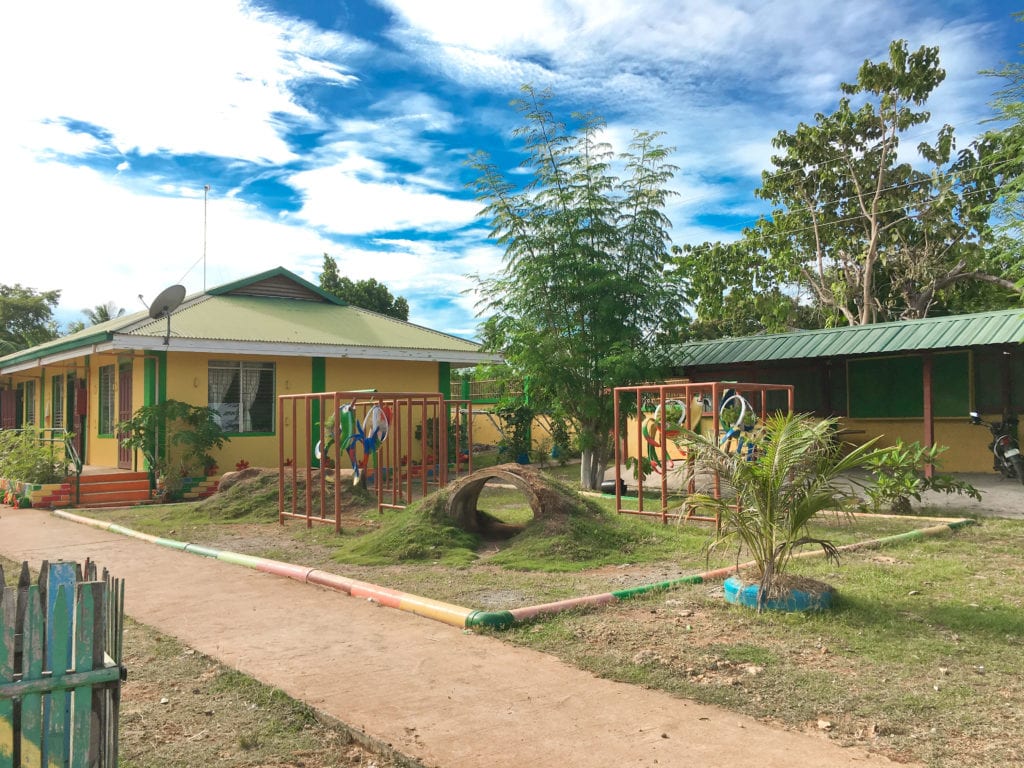

Sport
As is common through the Philippines, ‘sport’ is synonymous with cockfighting. It is an unusual sport in that the winner dies as well as the loser. Large sums are bet on the outcome of a fight, which usually lasts little more than one minute.
The birds themselves can look magnificent for their few brief moments of stardom, with purple-black plumage and a gold ruff.
There are several sports centres (cockpits) on the island. Smaller puroks just have an open-air arena. There is a large sports centre (cockpit) on the road to Santa Fe, which attracts a large clientele in Sundays. In addition, puroks can have their own arena, usually just a piece of land set aside for the purpose.
Festivals and processions
The Holy Week observance attracts large numbers of local and foreign tourists to the foot processions on Maundy Thursday and Good Friday, when life-sized images and icons are mounted on carrozas (floats) decorated in a carnival style that depict various tableaux of Christ’s Passion and the Stations of the Cross.
Palawod is another festival held 29 June in honour of Sts Peter & Paul. The street dancing and ritual showdown competitions which depict the fishing traditions of Bantayan have contributed to Palawod’s being the 3-times Grand Champion of the Pasigarbo sa Sugbo Festival of Festivals.
Sinulog takes place at the end of January, when there are ten or more days of noisy celebration.
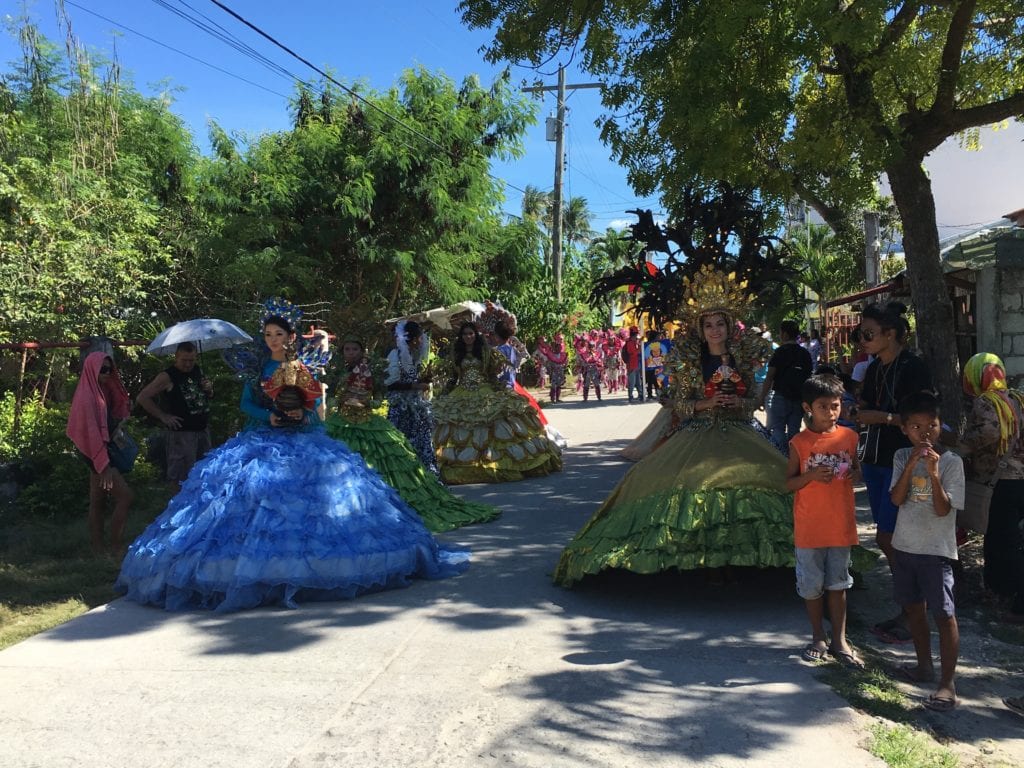

Notable Dates
1580: The Augustinians established the Parish of Bantayan as a convent under the patronage of La Asuncion de Nuestra Señora (The Ascension of Our Lady), a mission-station of the friars in the Visayas and thus the first parish in Cebu province and one of the few parishes still in existence outside Mexico which were once a part of the Archdiocese of Mexico.
1603: The Augustinians relinquished the administration of the church to the secular clergy. During the time of Bishop Pedro de Arce, Daan Bantayan (also Daanbantayan) and the nearby villages located in northern Cebu were placed under the administration of the parish, followed by the island of Maripipi.
1628 : The biggest Moro attack took place when a fleet of vintas attacked, killing or abducting more than 800 natives mostly from the village of Hilingigay, now barangay Suba, and burning down the church. Juan de Medina wrote that the priest and a few Spanish residents tried to defend but had to run and hide after running out of ammunition.
1754: Moro raid left the church and community in ashes.
1778: The old Spanish roads linking Santa Fe, Bantayan and Madridejos were constructed through forced labour.
1790–1796: Severe famine after crop failure. Not even a grain of corn could be had but the people subsisted upon amorseko (crab grass) which continuously grew on the walls of their nipa huts.
1860: The first casa real was constructed (now Municipal Hall).
1864: Following the Education Decree of 1863, the first Spanish school (for boys) was established under the direct supervision of the curate where religious instruction was instilled.
1880–1890: Smallpox epidemic devastated the island
1894: The entire barrio of Ticad was razed to the ground by fire. Only the stumps of the posts could be seen above the ground.
1902–1903: Cholera epidemic.
1905: Typhoon, First local election in Bantayan. Gregorio Escario, who had been appointed as first “Presidente”, now won the election by a small margin over his rival.
1906: The first bicycle came to Bantayan, owned by Leon Villacrusis. It was imported from Manila. The first bicycle imported from Japan was owned by Dr. Mabugat.
1908: Smallpox epidemic, eventually controlled by complete vaccination.
1910: The first motorized boat, MV Carmela, was owned by Yap Tico. It served the Bantayan–Cebu route. It also brought merchandise to and from Bantayan until it was destroyed by the typhoon of 1912.
1912: Typhoon, which took hundreds of lives in addition to work animals and agricultural crops that were destroyed.
1913: Construction of the present Bantayan–Santa Fe road began.
1915: As a result of Public Act 1801, the main building of Bantayan Central School was built.
1918: Construction of the Bantayan–Madridejos road began.
1923: The first car came to Bantayan island – a second-hand Dodge owned by Kapitan Casimiro Batiancila of Santa Fe.
1924: The whole road construction project linking Santa Fe, Bantayan and Madridejos ended.
1927: Bantayan Postal Office was opened within the municipal building.
1930: Cholera epidemic
1935: Beer was first distributed in Bantayan.
1961: Oil explorers came to Bantayan to dig the first oil well somewhere within Patao and Kabac.
1968:
A fire that started in San Pedro Bakery gutted 17 houses and claimed the life of one person.
A storm washed away the historic watchtower in Baluarte, Suba.
1973: Fire broke out which destroyed almost the whole section of Suba, razed the entire public market and rendered more than 700 families homeless.
1978: Death of Isidro R. Escario, who had been mayor of Bantayan since 1937 apart from the war. His funeral procession and wake drew thousands: people were seen queueing one kilometre away from the wake.
1981: Presidential decree nominates Bantayan as a National Protected Area: Wilderness area.
1997: Death of Antonio Ilustrisimo (born Bantayan 1904). He was a Master of Kali Ilustrisimo – his own development of the eskrima he learned from his father.
1999: Overloaded ferry MV Asia South Korea en route Cebu–Iloilo City strikes submerged rocks about 8 nautical miles (15 km; 9 mi) west of Bantayan island and sinks in heavy seas with loss of 56 lives.[56][ab]
2010: Lipayran island hit by tornado – 15 shanties destroyed and seven damaged.[57]
2013: Class‑5 Super Typhoon Haiyan, within Philippines known as Yolanda, caused considerable damage to the entire island, but with relatively little loss of life.
2020: COVID-19
About SYKE Travel & Tours
Travel and Tours for Bantayan Island, Visayas Region and entire Philippines
Customized travel Packages and travel Services for Bantayan Island but also other scenic places in the Philippines. We are specialized for Travel Packages and Activities in Bantayan Island and welcome you anytime in our cozy Hotel (SMAK’s Hotel) in Santa Fe.
Who we are
When we talk about ‘We’ we mention Kristine P. Cosep (born in the Philippines) and Stefan M. Welter (born in Switzerland) and of course everyone of our valuable staff. Together we combine two different nations and create a unique service for your stay in the Philippines. We talk the languages English, Tagalog (Filipino), Visayas, German (and Swiss German), French and Spanish.
Our Motivation
We founded our agency in 2017 under the name of ‘SYKE Travel & Tours’. The Name SYKE comes on the one hand from the combination of the first letters of our names (S and K). Historically and to Greek mythology, SYKE was one of those nymphs who live in trees and are intimately connected with the fate of the nature.
Nature plays a big role for us personally but also for our business. As a travel agency situated in Bantayan Island we are very concerned about the future-proof of the nature and the beauty of Bantayan Island with all its surrounding Islands.
We also take the sustainable future of the tourism business in Bantayan Island very serious. But in our opinion it always has to be in harmony with our nature, so tourism will stay also in the future a very strong and important part of the economy of our Island.
This is, what SYKE Travel & Tours is about and we hope to serve you also in the future with memorable tours in the Philippines.



